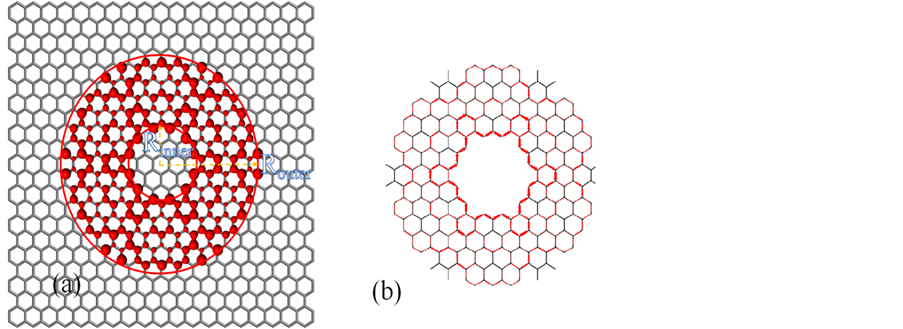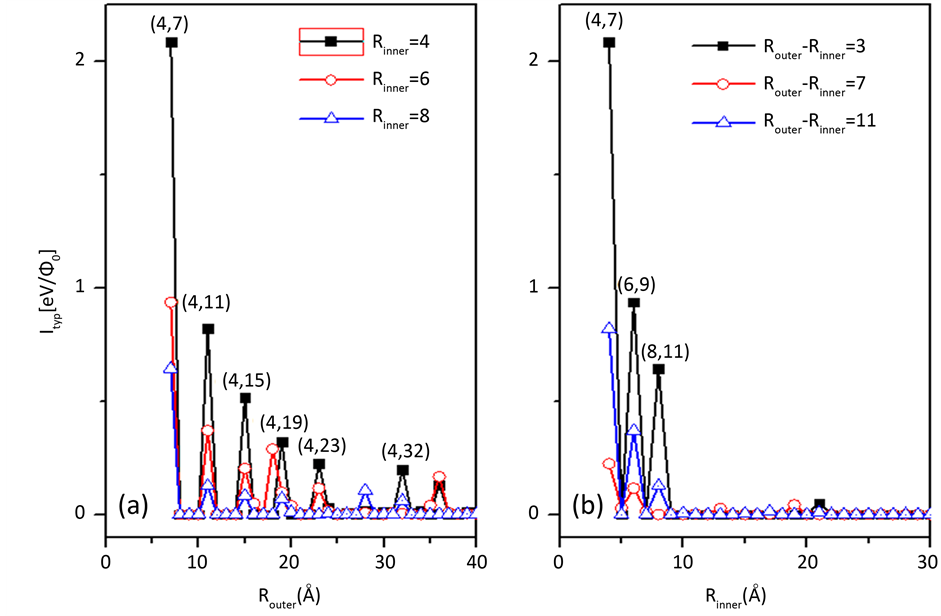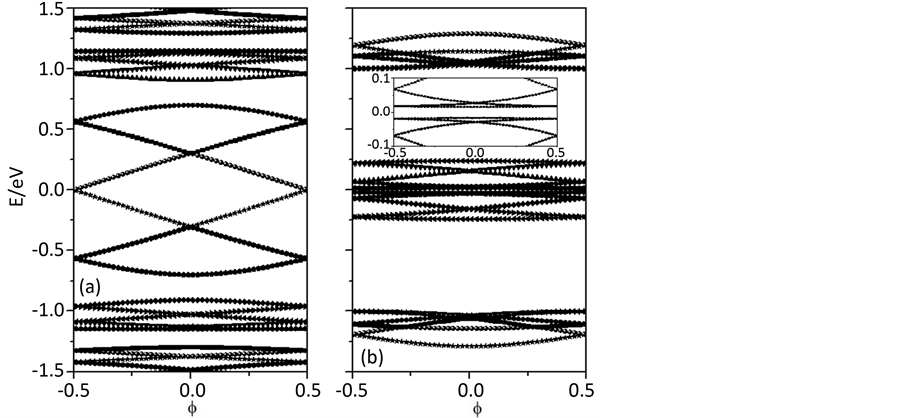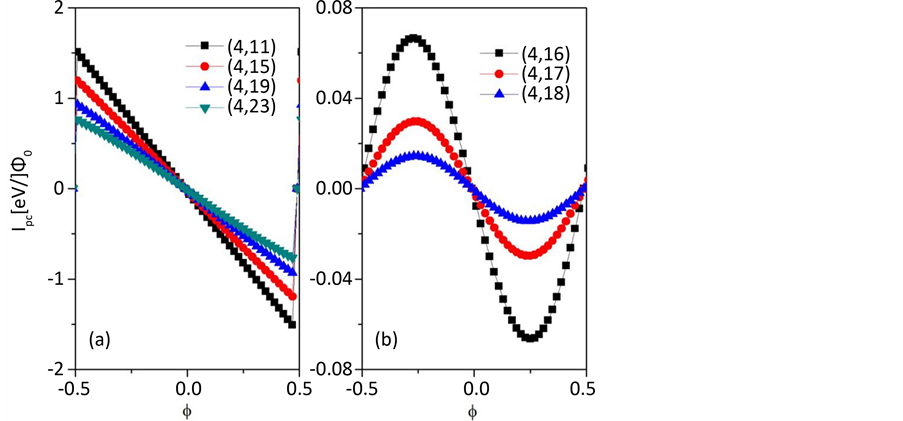Applied Physics
Vol.07 No.03(2017), Article ID:20148,6
pages
10.12677/APP.2017.73010
Electronic Structure and Persistent Current in Graphene Rings
Jingjing Miu, Xiaoyuan Zhang, Youjing Shi, Haiyang Zhang, Ning Xu*
School of Mathematics, Yancheng Institute of Technology, Yancheng Jiangsu

Received: Mar. 13th, 2017; accepted: Mar. 28th, 2017; published: Mar. 31st, 2017

ABSTRACT
The electronic structure and persistent current of graphene rings have been studied using the tight-binding model. Our results show that in the presence of a perpendicular magnetic field, energy spectrum can be grouped into bands with six levels per band owing to inter-valley scattering. According to degeneracy of energy level at the Fermi energy, the graphene rings are divided into two groups, metallic and semiconducting rings. In metallic rings, the persistent current within a flux period changes linearly with magnetic flux ϕ, while it is a sinusoidal periodical function of ϕ in semiconducting rings. Both metallic and semiconducting rings exhibit diamagnetic response, because the electrons driven by magnetic flux flow anticlockwise along the rings.
Keywords:Graphene, Tight-Binding Model, Electronic Structure, Persistent Current
石墨烯纳米环的电子结构和持续电流
缪晶晶,张潇元,史友进,张海洋,徐宁*
盐城工学院,数理学院,江苏 盐城

收稿日期:2017年3月13日;录用日期:2017年3月28日;发布日期:2017年3月31日

摘 要
基于紧束缚理论,研究了石墨烯纳米环的电子结构和磁响应特性。计算结果表明当存在垂直磁场时,由于谷间散射,能谱中每个能带由六条能级组成。根据环的电子结构,石墨烯纳米环可以分为金属环和半导体环。在金属环中,持续电流随着磁通增大呈现线性变化关系。然而,半导体环的持续电流随着磁通增大呈现正弦函数关系。无论是金属还是半导体石墨烯环,磁通驱动下的电子都沿着环做逆时针运动,因而呈现出抗磁特性。
关键词 :石墨烯,紧束缚理论,电子结构,持续电流

Copyright © 2017 by authors and Hans Publishers Inc.
This work is licensed under the Creative Commons Attribution International License (CC BY).
http://creativecommons.org/licenses/by/4.0/


1. 引言
石墨烯(Graphene),一种可以从天然石墨(Graphite)中剥离出来的碳单原子层结构。自2004年首次发现以来,由于呈现出一系列特殊的电磁输运性质,在实验和理论方面吸引了大量的关注和研究 [1] [2] [3] [4] [5] 。通过采用机械剥离 [1] [2] 、控制Graphene的外延生长 [3] [4] 和机械切割 [5] 等方法,这种片层的Graphene能够被刻蚀或被组成不同形状的几何结构,这无疑是打开通往制造基于Graphene的纳米装置的大门。例如,可以制备出不同尺寸和形状的石墨烯纳米带 [6] 、量子点 [7] [8] [9] 、反点阵列 [10] 、场效应晶体管 [11] [12] 、石墨烯集成电路等 [13] 。最近,实验室成功制备出半径在200 nm~500 nm的石墨烯量子环 [14] 。其几何结构与介观环类似,是研究和确证量子相干和退相干效应的理想体系,为人们理论研究和实验检测持续电流提供了理想对象。对于不同形状的六角石墨烯环,有研究表明,其内外边沿态决定了其边沿是否对称以及环角的结构 [15] 。尤其是对于锯齿型六角石墨烯环,其电荷密度仅分布于两个对称的边沿,并且其内外边沿态存在耦合效应。锯齿型六角石墨烯环的电子结构与持续电流呈现出奇异的奇偶宽度效应 [16] 。由于量子霍尔效应,磁场诱导电子沿着环的内、外边缘做顺时针和逆时针运动 [17] 。
在当前工作中,基于紧束缚理论,我们计算了石墨烯纳米环的电子结构和持续电流。研究结果表明,石墨烯纳米环的持续电流很大程度上取决于环的几何构型。根据费米能级处的电子结构,石墨烯纳米环分为金属环和半导体环。在金属环中,最高占据态和最低未占据态在 处简并。电子主要局域于石墨烯纳米环的内边缘而形成延展态。持续电流随着磁通量增大呈线性变化。然而,在半导体环中,持续电流随着磁通ϕ做正旋变化,由于电子在磁场诱导下沿着环做逆时针运动,所以金属和半导体环都呈现出抗磁特性。
处简并。电子主要局域于石墨烯纳米环的内边缘而形成延展态。持续电流随着磁通量增大呈线性变化。然而,在半导体环中,持续电流随着磁通ϕ做正旋变化,由于电子在磁场诱导下沿着环做逆时针运动,所以金属和半导体环都呈现出抗磁特性。
2. 模型与方法
通过石墨烯刻蚀等方法可以获得石墨烯纳米环,如图1(a)所示。石墨烯纳米环的内、外半径分别为Rinner和Router,可以用(Rinner,Router)来表示环的结构,Rinner和Router的单位是Å。
图1(a)是(5,15)石墨烯纳米环。在当前工作中,基于单轨道近似紧束缚模型来研究不同构型石墨烯环的电子结构和持续的电流。磁场被限制在环的中心区域,并垂直于环的平面。不考虑电子-电子间相互作用,体系的哈密顿可以表示为
 (1)
(1)
其中 是格点势能,当前工作中设为零。
是格点势能,当前工作中设为零。 表示i和j格点的产生和湮灭算符。相邻两个格点间的
表示i和j格点的产生和湮灭算符。相邻两个格点间的

Figure 1. (a) Schematic illustration of (5,15) ring etched in graphene. LDOS of (5,15) ring at given E = 0 eV, which is represent by red circle, (b) Geometric and ring current structure of graphene Rings. The red arrows denote the current direction with their widths proportional to the current strength
图1. (a) (5,15)石墨烯环的几何结构,红点表示E = 0 eV时局域态密度,(b) 石墨烯环的电流元示意图,箭头表示电流的流向
跃迁积分表示为 ,
, [16] [17] 。
[16] [17] 。 是磁矢势,通过对角化哈密顿矩阵H可以得到环的电子结构。采用格林函数方法,可以得到局域电子态密度(LDOS),
是磁矢势,通过对角化哈密顿矩阵H可以得到环的电子结构。采用格林函数方法,可以得到局域电子态密度(LDOS),  [18] 。任意两个相邻格点间的电流元,
[18] 。任意两个相邻格点间的电流元,
 (2)
(2)
其中, 是费米因子,
是费米因子, 是与本征值
是与本征值 相对应的特征向量。石墨烯环的持续电流由下式给出:
相对应的特征向量。石墨烯环的持续电流由下式给出:
 (3)
(3)
其中, 为无量纲化磁通,其中
为无量纲化磁通,其中 为磁通量子。En为系统的能量,n代表相应的本征能级。持续电流随磁通周期性变化,周期为
为磁通量子。En为系统的能量,n代表相应的本征能级。持续电流随磁通周期性变化,周期为 。通常,人们感兴趣的是体系的典型电流,定义为 [19] :
。通常,人们感兴趣的是体系的典型电流,定义为 [19] :
 (4)
(4)
在当前计算中,能量E以 为单位,当温度小于400 k时,电声子相互作用对持续电流影响较小 [20] 。因此,在该工作中不考虑电声子相互作用。
为单位,当温度小于400 k时,电声子相互作用对持续电流影响较小 [20] 。因此,在该工作中不考虑电声子相互作用。
3. 结果和讨论
为了探讨量子尺寸效应对石墨烯纳米环典型电流的影响,图2给出典型电流随着外径增大的变化关系。从图2(a)中可以发现,对于给定内径的石墨烯纳米环,典型电流随着外径增大而减小,并伴随许多振荡峰。(4,7)、(4,11)、(4,15)、(4,19)、(4,23)、(4,32)石墨烯纳米环有非常大的典型电流。同样,当环的宽度给定时,随着外径增大,典型电流逐渐减小,同样伴随着大量的振荡峰。例如,(4,7)、(6,9)、(8,11)石墨烯纳米环拥有大的典型电流。这些给定环具有非常大的典型电流引起了我们的关注,为了寻求答案,我们将进一步计算石墨烯纳米环的电子结构和环流结构。
为了阐明石墨烯纳米环的磁响应机制,图3给出了(4,15)、(4,16)硅烯纳米环在费米能附近的电子结构。这两个环具有相同的内径Rinner = 4 Å。从图3中可以发现,磁通相关的能谱分成一系列能带,每个能带包含六个能级。这可能是由于石墨烯环的六重旋转对称性结构所带来的奇异电子结构。对于环内的每个格点,都存在与之等价的五个格点。由于这六个格点之间的距离相对较远,它们之间相对较弱的耦合

Figure 2. (a) Thetypical current vs. outer radius at the given inner radius. (b) At given the difference between inner and outer radius, the induced typical current vs. inner radius
图2. 石墨烯环的典型电流随着(a)环的外径和(b)环的内径之间的变化关系

Figure 3. Energy spectra as a function of magnetic flux for (a) (4,15) and (b) (4,16) rings
图3. (a) (4,15)和(b) (4, 16)石墨烯环的电子结构

Figure 4. Persistent current of (a) metal and (b) graphene rings as a function of magnetic flux
图4. (a)金属和(b)半导体石墨烯环的持续电流
可能导致出现包含六能级的能带。然而,超胞内的每个格点,它不仅与邻近格点有强烈的相互作用,而且在超胞相邻地方存在谷间散射,这将导致能带之间带隙的出现。在图3中,发现电子结构很大程度取决于环的宽度。对于(4,15)石墨烯纳米环,最高占据态和最低未占据态在 处简并。表示样品是金属环。而(4,16)环,在
处简并。表示样品是金属环。而(4,16)环,在 存在窄能隙,表明样品环是窄隙半导体环。进一步计算结果表明,金属环拥有较大典型电流,而半导体环的典型电流相对较小。
存在窄能隙,表明样品环是窄隙半导体环。进一步计算结果表明,金属环拥有较大典型电流,而半导体环的典型电流相对较小。
根据石墨烯纳米环的电子结构,我们计算了石墨烯环的持续电流,如图4所示。研究发现石墨烯纳米环呈现出抗磁性。图1(b)给出了环的电流密度。从图1(a)中,可以发现电子主要局域在石墨烯纳米环的内边缘,构成延展态。这些电子在磁场的驱动下沿着环自由流动,构成边缘态环流结构。正是这些围着环流动的电子导致环呈现出抗磁相应。此外,发现磁通相关的持续电流随着磁通ϕ增大做周期性变化,如图4(a)所示。在ϕ = 0.5处,持续电流突然增大,如图3(a)所示,此处对应能级简并。相对金属环,半导体环持续电流下降两个数量级。持续电流随着磁通增大呈现出正弦函数关系。这是由于半导体环在费米能处有一个窄的带隙和较小电子群速度。磁通相关的持续电流随着磁通增大正弦变化。
4. 结论
采用单p轨道紧束缚方法,详细地研究了石墨烯纳米环的电子结构和持续电流。研究发现由于石墨烯纳米环的谷间散射,磁通相关的能谱由若干个能带构成,每个能带包含四条能级。根据费米能附近处的电子结构,石墨烯纳米环可以分为金属型和半导体型。对于金属环,持续电流随着磁通增大线性变化,而对于半导体环,持续电流随着磁通增大呈现出正弦函数关系。由于磁通驱动的电子沿着环逆时针运动,因此,金属和半导体环都呈现出抗磁特性。这些结果对基于石墨烯环的分子器件的设计与应用具有指导作用。
基金项目
国家自然科学基金青年基金项目(11404278,11647072)。
文章引用
缪晶晶,张潇元,史友进,张海洋,徐 宁. 石墨烯纳米环的电子结构和持续电流
Electronic Structure and Persistent Current in Graphene Rings[J]. 应用物理, 2017, 07(03): 71-76. http://dx.doi.org/10.12677/APP.2017.73010
参考文献 (References)
- 1. Novoselov, K.S., Geim, A.K., Morozov, S.V., et al. (2005) Two-Dimensional Gas of Massless Dirac Fermions in Graphene. Nature, 438, 197-200. https://doi.org/10.1038/nature04233
- 2. Zhang, Y.B., Tan, Y.W., Stormer, H.L. and Kim, P. (2005) Experimental Observation of the Quantum Hall Effect and Berry Phase in Graphene. Nature, 438, 201-204. https://doi.org/10.1038/nature04235
- 3. Berger, C., Song, Z., Li, X., Wu, X., Brown, N., Naud, C., et al. (2006) Electronic Confinement and Coherence in Patterned Epitaxial Graphene. Science, 312, 1191-1996. https://doi.org/10.1126/science.1125925
- 4. Berger, C., Song, Z., Li, T.B., et al. (2004) Ultrathin Epitaxial Graphite: 2D Elextron Gas Properties and Route toward Graphene-Based Nanoelectronics. The Journal of Physical Chemistry B, 108, 19912-19916. https://doi.org/10.1021/jp040650f
- 5. Hiura, H. (2004) Tailoring Graphite Layers by Scanning Tunneling Microscopy. Applied Surface Science, 222, 374- 381.
- 6. 刘守鹏, 等. 人工裁剪制备石墨纳米结构[J]. 物理学报, 2005, 54(9): 4251-4255.
- 7. Berger, C., Song, Z., Li, X., Wu, X., Brown, N., Naud, C., Mayou, D., Li, T., Hass, J., Marchenkov, A.N., Conrad, E.H., First, P.N. and Heer, A. (2006) Electronic Confinement and Coherence in Patterned Epitaxial Graphene. Science, 312, 1191-1196. https://doi.org/10.1126/science.1125925
- 8. Novoselov, K.S., Jiang, Z., Zhang, Y., Morozo, S.V., Stormer, H.L., Zeitler, U., Maan, J.C., Boebinger, G.S., Kim, P. and Geim, A.K. (2007) Room-Temperature Quantum Hall Effect in Graphene. Science, 315, 1379-1381. https://doi.org/10.1126/science.1137201
- 9. Ponomarenko, L.A., Schedin, F., Katsnelson, M.I., Yang, R., Hill, W., Novolevov, K.S. and Geim, A.K. (2008) Chaotic Dirac Billiard in Graphene Quantum Dots. Science, 320, 356-358. https://doi.org/10.1126/science.1154663
- 10. Shen, T., Wu, Y.Q., Capano, M.A., Robickinson, L.P., Engel, L.W. and Ye, P.D. (2008) Magneto-Conductance Oscillations in Graphene Antidot Arrays. Applied Physics Letters, 93, 122102-122104. https://doi.org/10.1063/1.2988725
- 11. Obradovic, B., Kotlyar, R., Heinz, F., Matagne, P., Rakshit, T., Giles, M.D., Stettler, M.A. and Nikonov, D.E. (2006) Analysis of Graphene Nanoribbons as a Channel Material for Field-Effect Transistors. Applied Physics Letters, 88, 142102-142105. https://doi.org/10.1063/1.2191420
- 12. Echtermeyer, T.J., Lemme, M.C., Bolten, J., Baus, M., Ramsteiner, M. and Kurz, H. (2007) Graphene Field-Effect Devices. The European Physical Journal Special Topics, 148, 19-26. https://doi.org/10.1140/epjst/e2007-00222-8
- 13. Areshkin, D.A. and White, C.T. (2007) Building Blocks for Integrated Graphene Circuits. Nano Letters, 7, 3253-3259. https://doi.org/10.1021/nl070708c
- 14. Recher, P., Trauzettel, B., Rycerz, A., Blanter, Y.M., Beenakker, C.W.J. and Morpurgo, A.F. (2007) Aharonov-Bohm Effect and Broken Valley Degeneracy in Graphene Rings. Physical Review B, 76, 23540-235404. https://doi.org/10.1103/PhysRevB.76.235404
- 15. Bahamon, D.A., Pereira, A.L.C. and Schulz, P.A. (2009) Inner and Outer Edge States in Graphene Rings: A Numerical Investigation. Physical Review B, 79, 125414-125421. https://doi.org/10.1103/PhysRevB.79.125414
- 16. Ma, M.M., Ding, J.W. and Xu, N. (2009) Odd-Even Width Effect on Persistent Current in Zigzag Hexagonal Graphene Rings. Nanoscale, 1, 387-390. https://doi.org/10.1039/b9nr00044e
- 17. Xu, N., Chen, Q., Tian, H.Y., Wang, B.L. and Ding, J.W. (2016) Diamagnetism in Zigzag Hexagonal Graphene Rings. Physics Letters A, 380, 1102-1104.
- 18. Xu, N., Wang, B.L., Shi, D.N., Wang, Y.Z. and Zhang, C. (2012) Fano Resonance in Graphene Anti-Dot and Periodic Graphene Anti-Dot Arrays. Physics Letters A, 376, 3322-3325.
- 19. Louis, E., Verges, J.A. and Chiappe, G. (1998) Dimensional and Band-Structure Effects on Persistent Currents in Mesoscopic Metallic Rings. Physics Letters B, 58, 6912-6919. https://doi.org/10.1103/PhysRevB.58.6912
- 20. Omidi, M. and Faizabadi, E. (2015) Energy Spectrum and Persistent Current in an Armchair Hexagonal Graphene Ring in the Presence of Vacancies, Rashba and Zeeman Interactions. The European Physical Journal B, 88, 30. https://doi.org/10.1140/epjb/e2014-50607-1